Last-Minute NYC Holiday Gift Guide 🎁
We’ve created a holiday gift guide with presents for the intrepid New Yorker that should arrive just in time—


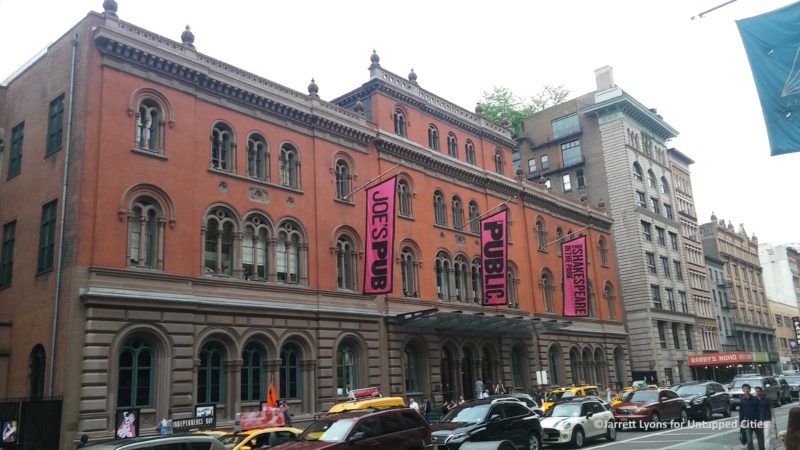
The theaters in and around Times Square have incredible architecture and history, but for almost sixty years, there has been another incubator for plays and performance making history and influencing the Great White Way far south of 42nd Street.
The Off-Off-Broadway movement started around 1958, when a young Italian-American gay man opened up a cafe where he and his friends could get together and share poetry, music and art. Eventually those friends started writing and performing plays in the Caffe Cino, which got the ball rolling on an entire theatrical movement.
The Off-Off-Broadway movement still thrives today.
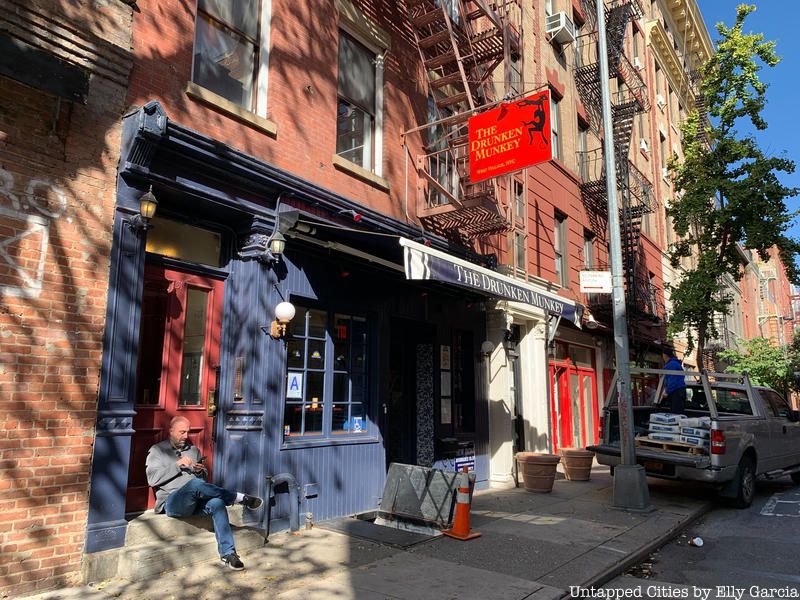
Caffe Cino, a small café that was at 31 Cornelia Street in Greenwich Village is widely recognized as being the first home to the Off-Off-Broadway movement. Joe Cino was a retired dancer who opened up the storefront as a cafe in 1958 as a space for his artist and poet friends to congregate. Many of these plays had homosexual themes and the theater became a space for the gay community to meet. Plays were performed multiple times a night and many of the playwrights who premiered work at Caffe Cino would also develop work at other theaters. Caffe Cino longer exists but you can read more in the book Caffe Cinno: The Birthplace of Off-Off Broadway.
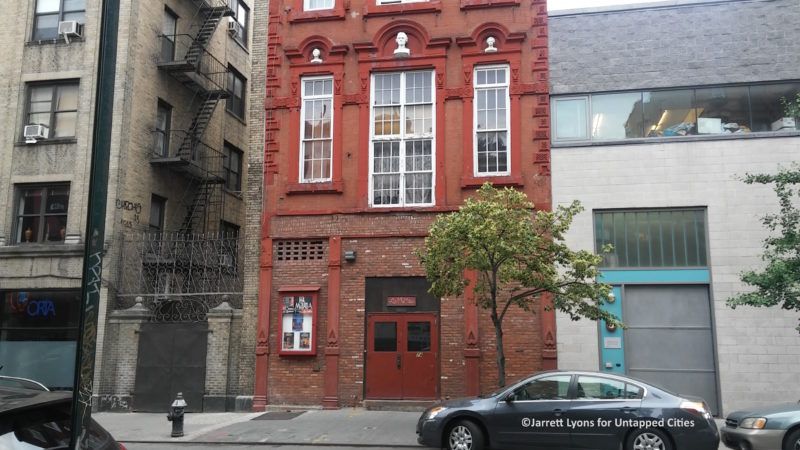
Another originator of the Off-Off-Broadway movement was La MaMa Experimental Theatre Club. La MaMa is an avant-garde, experimental and international performance venue in the East Village. The theater was founded by dress maker Ellen Stewart when she offered her East Village basement as a place for her foster brother to put on his plays. Stewart had no experience in the theater and corresponding laws, so she had to move a number of times until La MaMa settled at the current complex on East Fourth Street.
Because of Stewart’s accessible nature and open minded support of playwrights, La MaMa has been invaluable to the worldwide theater community. Playwrights Sam Shepard, Lanford Wilson and Harvey Fierstein were all nurtured at La MaMa. Robert De Niro, Whoopi Goldberg, Patti Smith, and Bette Midler also walked across the stage here. Other works nurtured at La MaMa that became mainstream successes include the musicals Godspell and Hair.
This summer at La MaMa catch a living history tour questioning the relationship between audience and performers, a play about Ukrainian poet Taras Shevchenko and a punk redux of Verdi’s Rigoletto.
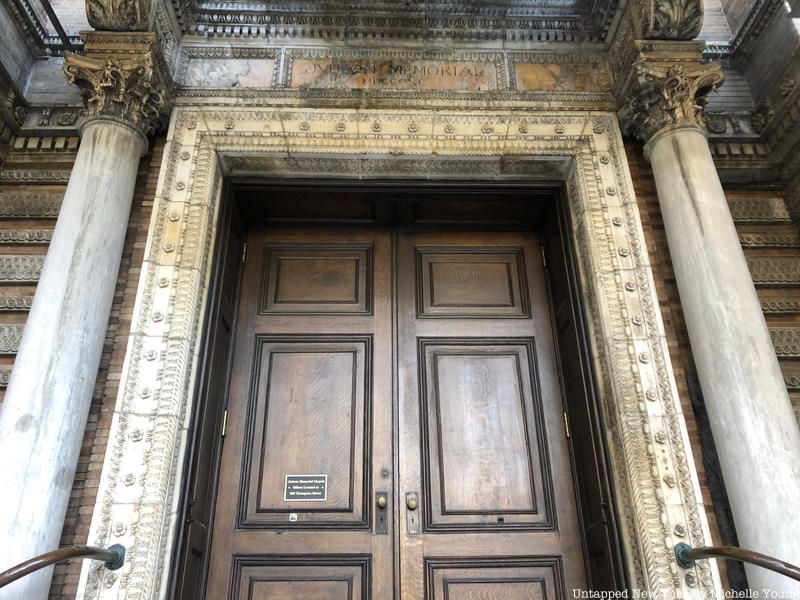
The landmarked Judson Memorial Church has a long history with the performing arts. In the 1950s, the church became a space where performers and other artists could make work without censorship. Reverend Al Carmines, the associate pastor of the church from 1961 through 1981, focused his ministry on the arts.
In 1961, the Judson’s Poets Theater found a home here and swept the church up into the Off-Off-Broadway movement. The church continued to present political work in the 1970s and ’80s and currently houses three performing organizations: The Gym at Judson and Magic Time incubate new performance and theater works and The Bailout Theater hosts free home-cooked dinners and entertainment.
Every month at Judson, Magic Time features a new playwright. Next month’s playwright is Monet Hurst-Mendoza.
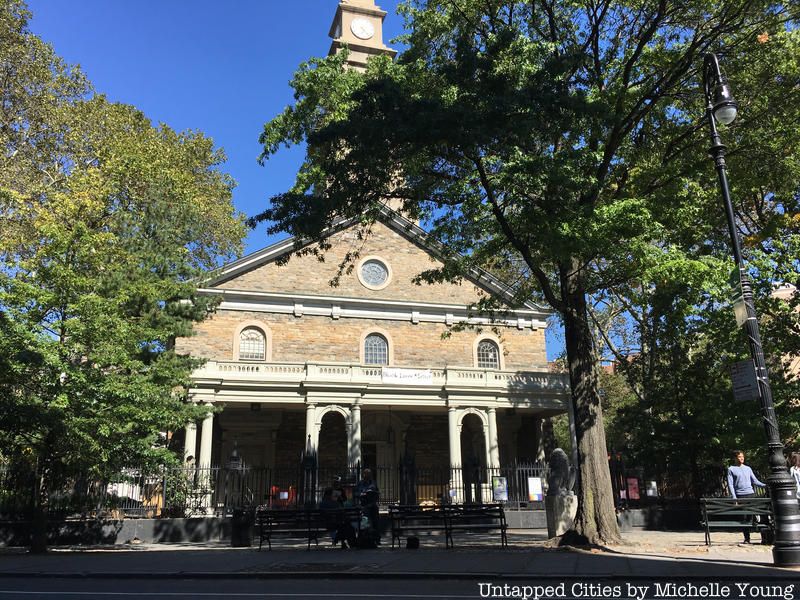
St. Marks Church-in-the-Bowery has been simultaneously operating as a place of worship and an arts space since the early 20th century – Patti Smith gets her start there as a performer at the St. Mark’s Poetry Project. The church became specifically became involved in the Off-Off-Broadway movement in 1964 when Theatre Genesis was founded and began performing there.
Like many theaters involved in the original historic movement, the church presented influential early work of playwrights Sam Shepard and Lanford Wilson. According to Newtopia Magazine, Kahlil Gibran also presented some early readings of “The Prophet” at St. Mark’s Church and was even appointed to the St. Mark’s Arts Committee in 1919.
This month at St. Mark’s Danspace Project features Catherine Gallant. Listen to some work from the St. Mark’s Poetry Project on Soundcloud.
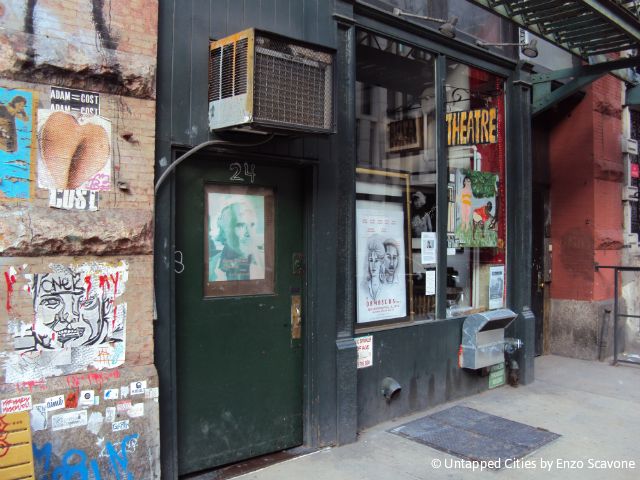
The Gene Frankel Theatre was founded in 1949 by actor/director/teacher Gene Frankel. Frankel was a member of the Actors Studio and is widely regarded for bringing African American themes to the theatre during the civil rights movement as a director both on and Off-Broadway.
Twenty-four Bond Street in Greenwich Village (now NoHo) was the last place where Frankel did his work. Frankel entrusted the theater to his assistant Gail Thacker, who has run the venue since since Frankel’s death in 2005. Actors Walter Matthau, Anne Bancroft, and Raul Julia have all been taught or directed by Frankel. The Gene Frankel Theatre at 24 Bond Street was also the home and studio of Robert Mapplethorpe from 1973 to his death in 1989.
A “living gallery” can be “experienced” this month at the Gene Frankel.
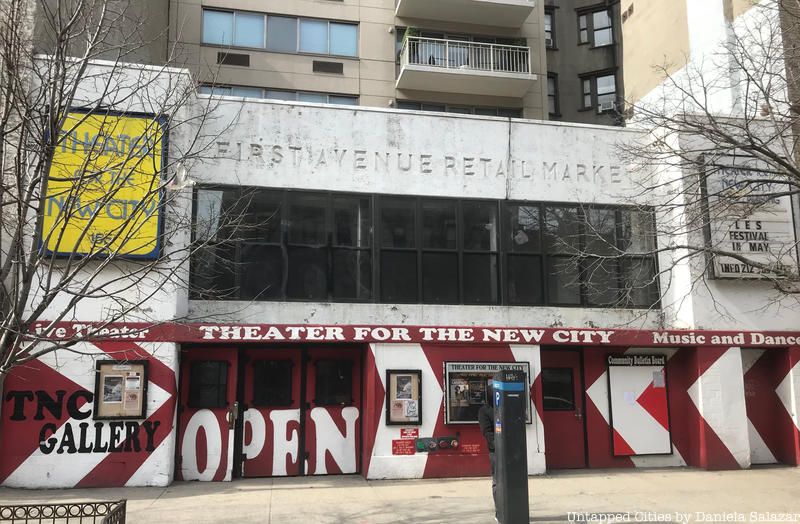
Theater for the New City was founded after the Off-Off-Broadway movement. The theater was established in 1971 to produce radical plays and engage with their local communities. In the theater’s s initial years, the theater moved around. The theater originally set their roots at the Westbeth Artists Community in the West Village, a community which still exists today. The group then traveled to the Jane Street Theater before making a pit stop at a former tabernacle church in the East Village and finally settling down in a former retail market that was re-designed. This is where Theater for the New City still lives today.
Aside from producing many influential playwrights that made their impact in other theaters on this list, TNC (as it is affectionately referred) is dedicated to community involvement. Programs like the Lower East Side Festival for the Arts and an annual five borough tour of original plays with local community actors are some of the ways that TNC engages the community.
A little known fact is that Theater for the New City started the annual Village Halloween Parade. TNC will be running its annual Summer Street Theater Tour in August.
<
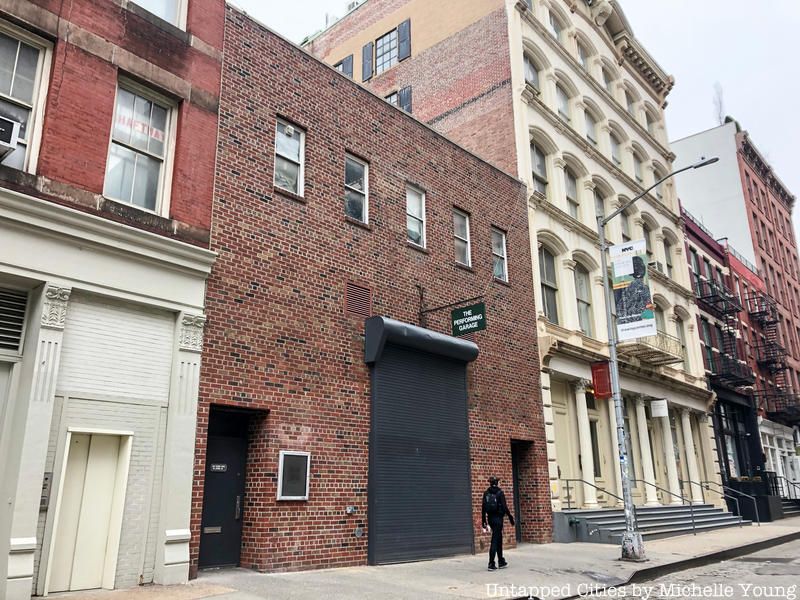
The Performing Garage is located in the Soho-Cast Iron District. The space is a former metal stamping facility turned theater and performance in 1968. The garage was initially home to the Performance Group, known for redesigning the space for every production. Most of the group’s works were radical reinterpretations of classics.
By 1980, the group had changed its name and leadership. The Wooster Group took its name from the street where the garage was located. Founding members of The Wooster Group include influential performance artist Spalding Gray and actor Willem Dafoe.
The Wooster Group is currently preparing for a tour of The Town Hall Affair. Check them out if you happen to be in Antwerp in September or Paris in October.
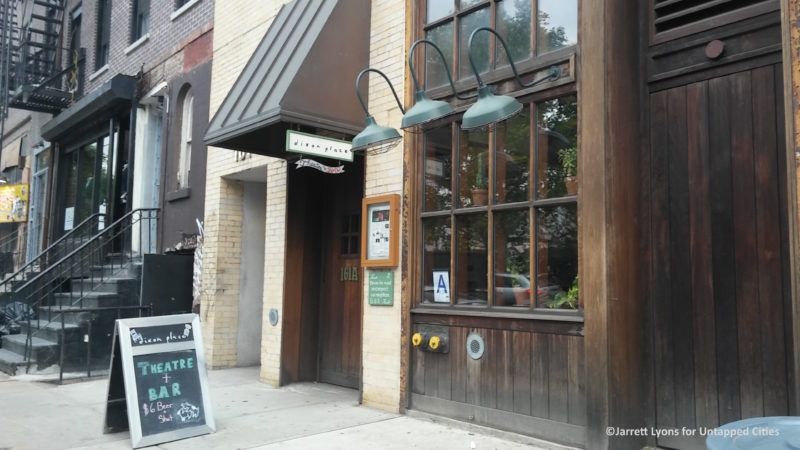
Dixon Place was founded in 1986 by Artistic Director Ellie Covan in her Paris apartment. The next year, she moved to the Lower East Side and began nurturing new works by artists there. The theater includes a full bar, a living room designed space, and a main theater.
Many influential artists and entertainers have walked through Dixon’s doors including Lily Tomlin, BD Wong, Justin Vivian Bond, Wallace Shawn, and the band, They Might be Giants. Coming up at Dixon Place is the popular “Hot Festival” of queer performance that dubs itself “the oldest annual festival of its kind.” Dixon Place is located at 161A Chrystie Street on the Lower East Side.
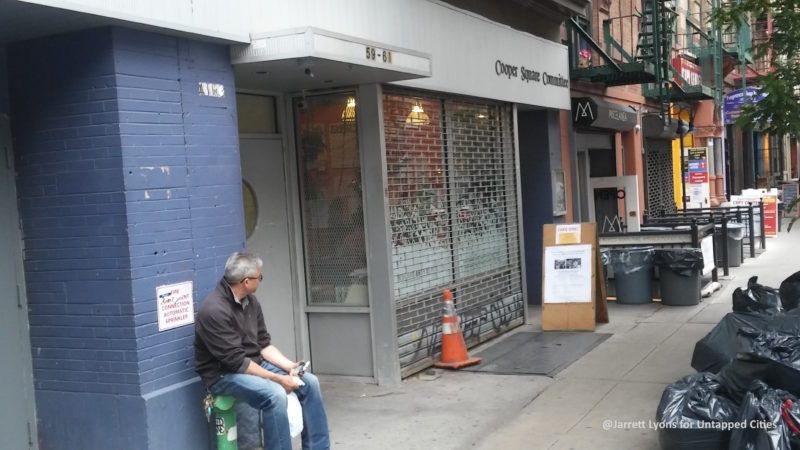
Women’s One World is a feminist theater in the East Village that was founded in 1980 as a Feminist Theater Festival. The Café is currently located in the East Village Historic District where many Off-Off-Broadway theaters were born.
WOW has the important distinction of being the “oldest collectively-run performance space for women and/or trans artists in the known universe,” according to their website. Influential performance group Split Britches were initially involved in the founding of the space. Lisa Kron, Tony Award winner for the book and lyrics to Fun Home on Broadway also presented work at WOW.

The Public is technically an Off-Broadway venue, but it has ties to the Off-Off-Broadway community. Like the Off-Off-Broadway movement the Public’s founder, Joseph Papp, used many innovative spaces in the theater’s early years.
Papp’s first production of Shakespeare’s Taming of the Shrew took place in the East River Amphitheater in the John V. Lindsay East River Park in 1956. He continued to produce theatre in unique spaces. Papp eventually moved his productions uptown to the Delacorte Theater in Central Park, where Shakespeare in the Park still runs annually every summer.
Papp finally moved his work to where it lives today, The Public Theater which houses five theaters and Joe’s Pub, a cabaret space. The Library Bar is an homage to the fact that the space used to be the Astor Place Library, the first library in New York.
Currently running at the public is The Total Bent by the creators of the Tony Award winning show, Passing Strange.
Hopefully this inspires some experimentation with your theatrical palette!
Next check out some other Shakespearean locations around the city and our exploration of repurposed theaters.
Subscribe to our newsletter